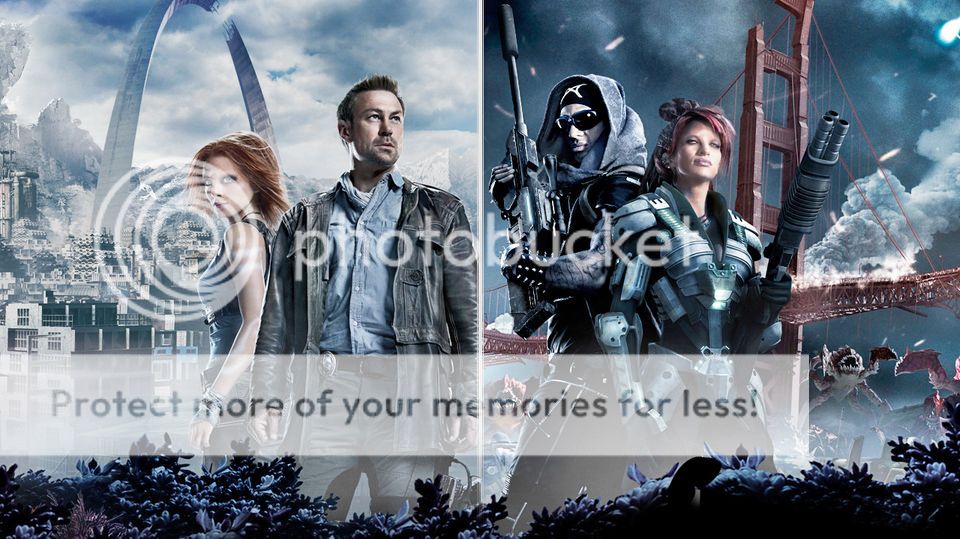
SyFy channel’s new show Defiance is breaking the mold in every way. An unusual combination of fantasy blockbuster, small town mystery and sci-fi action drama, Defiance takes place on a decimated, post-apocalyptic Earth set several decades into the future. After an alien invasion and war, hmans try to co-exist with a group of aliens that are both friend and foe in a small town literally defying the odds. ScriptPhD.com was extremely fortunate to have access to one of the head writers of the show, as well as its official science advisor. In our interviews, we delve deeper into the backbone of this sci-fi hit, which is a terrific, engaging story, paired with colorful characters and the clever incorporation of science to support the plot. More after the “continue reading” cut.
Defiance is set amidst a backdrop of the ruins of a major American city, formerly St. Louis, now called Defiance, where a group of humans and aliens must survive under extreme political and existential circumstances. Jeb Nolan, a former military hero who fought the last battle of the human-Votan war, aptly named the Battle of Defiance, is now a wanderer looking for his place in the world. His adopted daughter Irisa, from a Votan alien tribe called the Castathans, is also battling a difficult past as she migrates between the world of her own people as friends and foes. In the middle of episodic mysteries, such as who is behind an attack on Defiance, or the murder mystery of the town mining magnate’s son, is a larger storyline about the integration of human and alien races in a unique post-apocalyptic melting pot.
For the SyFy channel, Defiance looks like the first bona fide hit since Battlestar Galactica, whose prequel follow-up Caprica never managed to latch on with a consistent audience. It’s premiere had the highest ratings since Eureka and follow up episodes are holding a steady audience.
And if its intricate plot isn’t enough to keep viewers hooked, Defiance is defying traditional media by merging the show with a concomitant multiplayer online video game concept, where action takes place simultaneously in San Francisco. The events that take place in the video game, which has already recorded one million registered users, will impact the storyline of the show to varying degrees, and vice versa. It is without a doubt the most interactive and ambitious storytelling format ever attempted for the genre from a technical standpoint.
ScriptPhD.com was very honored to have the opportunity to sit down with both series writer and co-creator and executive producer Michael Taylor, as well as the show’s scientific advisor Kevin Grazier, to get a better idea of the characters, storyline and what we can expect going forward.

Taylor, also a series writer and producer on breakout SyFy hit series Battlestar Galactica, was involved in the early development of the series, which took over one and a half years to re-conceptualize and bring to the small screen from its initial concept. “Keep in mind, the original draft [of the pilot] was very different,” Taylor says. “The Chief Lawkeeper role was prototyped as this older, wry Brian Dennehy-type of character, for example. Irathient warrior Irisa was more of a wide-eyed, naïve girl than she is in the current version. We even had about two to three episodes of the series done. But as we went along, we were finding it hard to keep thinking up episodes from week to week.” Which is when the series went back to the drawing boards.
And reimagine the series they did! Unlike the vast majority of sci-fi shows, which explore the process of warring factions integrating and co-existing, in Defiance, this has already occurred, something that Taylor calls a “cool experiment.” “The 30-year-war has already been fought, all that stuff is long in the past,” Taylor reminds us. “And now we are at the point where the 8 races are trying to co-exist together. Remember, in the opening episode, the mayor [Amanda Rosewater] tells the multi-ethnic crowd that Defiance is a pretty nice place to live.” Which is in stark contrast to the vast majority of the now-destroyed Earth, which remains a very dangerous, primitive environment, as is seen in the opening minutes of the pilot. But the relatively peaceful, self-contained environment of Defiance is not the only way it differs. “This idea of the 8 races living together is still pretty rare [throughout Earth],” Taylor remarks. “In fact, in Rio de Janeiro you have the opposite with the Votan-led Earth Republic, which has pretty much the opposite goal than what’s happening in Defiance.”
People should also be careful about inferring too many sociological or current events extrapolations from the themes explored in the show. For Taylor, the writers and creators are mainly exploring a fun concept with strong storytelling and even stronger characters. And what characters they are!
Lawkeeper Jeb Nolan and his adopted daughter Irisa are both dark, complex characters with extremely difficult pasts. “In many ways, they complement each other and need each other,” Taylor says. “They are the only two people who can complete one another because of that bond.” But they aren’t the only characters with a past. New young mayor Amanda herself has some dark secrets that fuel her motivations, many of which will be explored in future episodes, according to Taylor. At the mere suggestion that mysterious ex-mayor Nicky, who figures into the Votan plot against the humans, might not be that evil, Taylor retorts: “Nope, she’s evil. She just rationalizes her actions as the end justifying the means.”
As for integrating the video game concept, it predated the show by five years, which allowed writers to establish stories and character development that will happen separately from, albeit concurrently with, the action in Defiance onscreen. It also affords the writers on the show some freedom with the knowledge that the events in the video game don’t necessarily impact the flow of the storyline right away. “With the production schedule of television, there’s no way that we would be able to incorporate plots from the video game into the show that quickly,” says Taylor. “But remember, there is a summer hiatus between seasons, so you never know. Maybe that would be a time the writers would be able to look at some of the events that gamers chose and fold them into the story with more leisure.”
So rest assured, those of you enjoying Defiance, whether on your televisions or XBoxes. Plenty of sci-fi action is yet to come.

In case viewers are worried that Defiance’s deep focus on character development and storyline layout (in two media formats no less!) is going to come at the expense of accurate and interesting science, fear not. The production staff at the sci-fi hit has employed the services of notable scientific advisor Kevin Grazier, who also advised on Eureka and Battlestar Galactica, along with a slew of feature films.
“We’ve seen time and time again small plot points that have become little tidbits, or plot points or even major points driving an episode when you get the science right,” Grazier notes. “Caring about the science [in a series plot] can be as much of a strength as it is a constraint.”
And while it’s true that the science of Defiance does seem a bit less obvious or upfront than in shows like BSG or Eureka, it’s no less important nor is it any less incorporated. “We have a really rich, really well thought-out backstory, and that is very much informed by the science,” Grazier says. “We know that the V-7 [Votan] races came from the Votan System. What happened to their system? Well, we have that [mapped out], we know that.” He also pointed to subtle implications such as in the first few minutes of the pilot. When Irisa looks up at the sleeper pods, she says, “All those hundreds of years in space just to die in your sleep.” Grazier notes: “The subtle implication is that the V-7 aliens don’t go FTL [faster than light]. So we have figured out where they’re from and how far away they’re from and which direction of the sky they’re from and how long it took to get here.”
In addition to its elemental role in the backstory, science has also also had fun ‘little’ moments in the show, like the importance of the terrasphere in defending the Volge attack in the pilot or the hell bugs (a genetic amalgam of several earth critters) in episode 3. Some of these small scientific details were even able to result in cool visual effects. For example, when the table of writers was discussing the ark falls, Grazier, an astrophysicist by training, noted that the conservation of angular momentum meant that these things would not land vertically, but rather horizontally, using the screaming overhead comets in Deep Impact as a touchstone. Sure enough, in the first few minutes, you see Nolan and Irisa tracking what’s about to be an ark fall and you see them screaming overhead. “That will, by the way, come into play in a later episode,” Grazier teases. “We know where the ark belt is. Where the ships were when they blew up, how far away they are.”
For Grazier, the experience has not only been a rewarding one, but different from the other shows he’s worked on. “Just to give you an example of how great the Defiance writing team is with regards to the science, in an upcoming episode, the writers had written a script and there was a big incident in there that I said “You can’t do this scientifically.”” Grazier kept shooting down suggestion after suggestion, with series producer Kevin Murphy, who was a huge Basttlestar Galactica fan, staying patient and open to ideas despite being frustrated by the process. In the end, the series producers allowed Grazier to provide input to the plot that both worked scientifically and resulted in decent storytelling and visual effects. “There was a situation that the scientific content was a sticking point, and a fairly major element of the plot, and they let the science guy come up with the solution,” he remarked. “As satisfying as some of the other series that I’ve worked on have been, that’s never happened to me before.”
“Obviously in any sci-fi show, there are going to be a few [unrealistic] gimmes, a few conceits for the sake of the plot or entertainment,” Grazier reminds us. “But if you buy in that these terrashperes came down and transformed the Earth and take this journey with us, then the science will take you the rest of the way.”
Based on the first three episodes, it’s a journey I know is worth the ride.
Watch a feature-length trailer for the show here:
Watch a special video about the making of the Defiance
Defiance airs on Monday nights on SyFy Channel at 9 ET/PT.
~*ScriptPhD*~
*****************
ScriptPhD.com covers science and technology in entertainment, media and advertising. Hire our consulting company for creative content development.
Subscribe to free email notifications of new posts on our home page.
]]>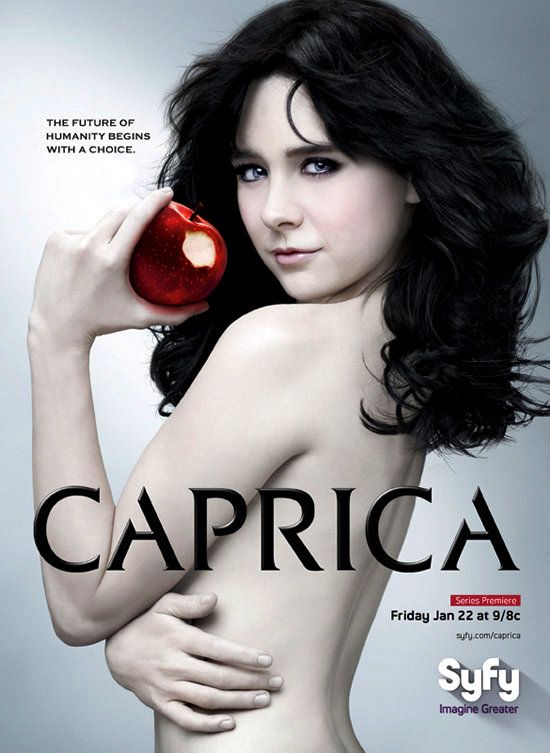
No one has been more excited about the premiere of Battlestar Galactica prequel Caprica than ScriptPhd.com. We eagerly joined the cast and crew of both shows last May during their joint panel at the Los Angeles Paley television festival. We were also one of the first sites to review the Caprica 2 hour pilot. And now, at long last, one of the most anticipated sci-fi prequels ever will premiere on the SyFy Channel this Friday. ScriptPhD.com’s Bryy Miller reviews the first three episodes and talks about the show’s early conceptualization and long-term promise. We are also extraordinarily fortunate and proud to bring you an Editor’s interview with series executive producer and show runner Jane Espenson, in which she talks about what we can expect from Caprica. Please click “continue reading” for full content.
REVIEW: Caprica
ScriptPhD.com Grade: B
The spin-off of SyFy ratings spectacular Battlestar Galactica has a lot in common with Shakespeare’s King Lear. Like King Lear, it is far more ambitious than any of Shakespeare’s previous works, both in scope and in depth (yes, even more so than Hamlet—but that’s for another article). In addition, it fleshes out the ensemble on a level far more fluid and psychological than what came before. But, as it turns out, being like King Lear is Caprica’s great flaw. The glitch, so to speak.
Caprica, for the benefit of new fans, is a follow-up to writer/producer Ronald D. Moore’s ambitiously verbose and successful science fiction series, Battlestar Galactica. Caprica’s main mission is to tell the creation story of the being that would one day become mankind’s greatest enemy, an artificial intelligence called the Cylon. Unlike other AI, these robots actually experience emotion and lead “full” lives. This, of course, will make for some rather interesting debates on the nature of intelligence, the soul, and war in general. Caprica takes place approximately 58 years before the events of Galactica, and while my brain is not scientific enough to compute if that is a short enough time span to encompass the full sequence of events, from the looks of it, they seem to be going at a realistic pace. In those 58 years, the Cylons don’t just sit around on the assembly line: they have to gain sentience, be mass produced, become a staple of everyday life, and start the FIRST Cylon war with humanity. Because there is quite a lot of story to tell, the central question is not whether the series is sustainable, but whether the story is worth telling.
Back to the Lear analogy. The thing about BSG was that, even though it possessed quite a large ensemble cast, it was plot-driven. Each character was essential to one overarching story, one goal. Caprica is not plot-driven. It is character-driven, and this is where it becomes a liability to be just like lil’ old King Lear. The writers of Caprica seem content to throw a lot of disparate characters all over the map doing completely different things and interweaving story arcs that feel as if a silk spider had gone to work on them. “It’s more about their personal lives,” admitted series creator/writer Jane Espenson at last year’s Paley event. “They don’t have the threat of death breaking down their neck every moment so that you can feel more lived in, you can explore this culture more.” Added Ronald D. Moore, “It’s a different show. I mean, losing the action-adventure is a risk…. [But] since there’s no Cylons coming in to sort of destroy the Galactica every once in a while, fate and humanity doesn’t hang in the balance yet.” Caprica writers even go as far as to make the main antagonist a polygamist, and give her family life a (sometimes bloated) spotlight. It’s as if they thought simply giving a character something to do would be high drama. Don’t even get me started on the subplot involving what seems to be an entire precinct of corrupt cops, three of which are introduced as part of the ensemble. My fears were not assuaged one bit when I saw that Ron Moore himself was on the writing staff. It may seem contradictory, me saying Ron Moore, the creator of a brilliant generation-defining show, writing for Caprica might be a bad thing. While he does a mean tap dance, Mr. Moore has a tendency to introduce plots into his shows without knowing what they have to do with said show. This is most apparent when he copped to not knowing where a pregnancy storyarc in BSG was going (among a human and Cylon, no less), and when he flat out stated that you don’t know where a season is going to end when you start writing it. This began many debates within the writing community if having a planned story versus on-the-fly writing mattered (the answer is, and always will be, yes). While initial publicity seemed to indicate that his involvement would be minimal, for Caprica’s sake, hopefully it is the Ron Moore of the earlier stages of Battlestar Galactica. It helps that the show is being helmed and written by equally brilliant BSG and Buffy the Vampire Slayer writer Jane Espenson.
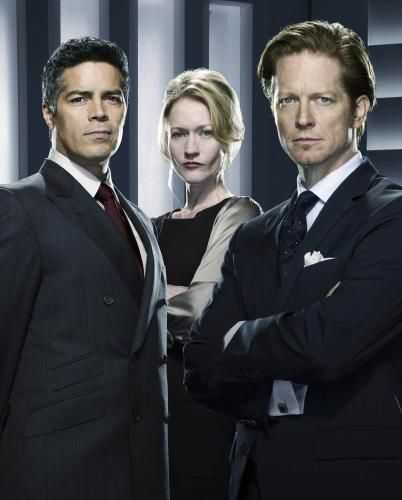
Our story begins with Daniel Graystone (Eric Stoltz), genius inventor, man about town, owner of seemingly everything. He is Bill Gates 2.0, and unbeknownst to him, his daughter Zoe (Allessandra Torresani), is busy creating artificial life in the form of a digital clone. The very first scene in the series is also the most confusing and frustrating, because it takes place in an Internet 8.0 lab of hers. Picture a fully interactive Second Life, overpopulated with the bored, the rich, and the dumb—which is not fully explained to the viewers in any coherent manner for at least thirty minutes into the two-hour pilot. There is a lot to like about Caprica. Every single concept in Caprica’s world was superb. Amazing. Despite visual and thematic superiority as one would expect from the BSG team, there were problems with early conceptualization. Everything seemed to be told to the viewer three times: once in vague technobabble that is supposed to sound too smart for us, once in a truncated layman’s speak, and yet another in a sort of mystic and supernatural definition. The problem is not with the idea but with its execution. Zoe’s invention—the Amoeba of the Cylons—is basically a search engine that can find genetic data and turn that into… well… memory. RAM. Gigahertz. It’s a fantastic way to explain true AI, the only problem is that the writers do so through the steps outlined before.
Tragedy occurs. Telling would be spoiling, but needless to say, Zoe dies in an accident that not only takes the life of the daughter of Joe Adams (Esai Morales), father of Galactica’s future commander Bill Adama, but also stirs the show’s significant dialogue on monotheism and the Cylons’ embrace of a One True God. Joe will come
into Daniel’s life later, but not before Zoe’s digital avatar says she felt Zoe die. It’s a Christmas Miracle. Daniel discovers this and is torn between being with his daughter once more and exploiting his dead spawn’s technological breakthrough to save his own dying company. Coinciding with Zoe’s death is a ticking clock on a government order for a perfect war machine robot, a hitherto failing experiment. It seems that Zoe 1.0’s death has caused a chain reaction resulting in a steady drop in shares, and the ire of Baxter Sarno (Patton Oswalt), a talk show host that has got to be the love child of Don Draper and Conan O’Brien.
Joe Adama’s story is one of woe from even before the mysterious accident. Adams is a Tauron, an ethnicity most despised out of all the horoscope-based groups of the Caprica/BSG universe. Joe resides as a lawyer in what is a Caprica take on Little Italy in the 1920s. I really loved these scenes, of which there are plenty, and could honestly watch the rest of the series—flaws and all—to its end simply for them. Joe’s brother is in the mob (another mobster looks strikingly similar to one of the 12 human Cylon models, FYI), teaching young Will Adams “street skills” that obviously and ultimately help make him so tough later on; Joe himself is in constant war over being a straight lawyer or being on the payroll. Indeed, at the end of the third episode, he does something so over-the-top that it risks making him seem unbelievable. Coming back to his ties to Graystone, he has a brilliant line about wanting to jump off a bridge that he says to the man during their initial meeting. In fact, both men do tremendous jobs of suffering incomprehensible pain for more than one episode, which I liked. Too many shows blithely brush off important deaths, or death in general. The two men become intertwined, first by loss, then by ideology. Even in conflict, they keep circling each other. But viewers lulled into thinking this is a simple “buddy” arrangement are dead wrong. Sometimes Greystone and Adams like each other, sometimes they don’t, but they always feel like they exist without the other. Graystone lets Adams in on his little “secret”, and their worlds crash into one another like a preordained destiny.
Zoe 2.0, it goes without saying, is the cornerstone of Caprica. No matter what else fails about the show, the ideas and concepts behind Zoe 2.0 shine through. Because Zoe 2.0 was “born” through blood, we get an interesting twist on the idea of violence being inherited; this time, however, it is digital inheritance instead of pure genetics. Because Zoe’s mother, Amanda (Paula Malcolmson), never knew her daughter in life, she has the possibility of getting to know her in death (this never happens in the first three episodes, but it is hinted that they will go down this road in some form). Male tech geeks unwittingly poke and prod at Cylon Zoe 2.0 when daddy downloads her in a prototype robot body, most likely commenting on how we objectify women in our society. Zoe’s “brain”, after being linked to her robot body for a limited time, refuses to work in other bodies, much like an organ being rejected. There’s also a hilarious scene involving Zoe 2.0 in the proto-Cylon shell which will forever be hailed as the ultimate walking-in-on-your-parents moment. Time will tell if these will remain brilliant and worthy science fiction concepts, or if they will be supplanted by other stories as the series evolves.
Overall, one would expect Caprica to have been a bit more polished, especially coming from the purebred creative stock that it is derived from, but it’s a pretty decent start to a prologue. Regardless of the flaws in the writing and story structure, Caprica has enough going for it to be at least a casual watch with a cult following from the previous series. It won’t be as good as people say, but it won’t be as bad as they say, either. Which is enough like King Lear as you can get, acclaim-wise.
Caprica airs on the SyFy Channel, Fridays at 9pm, premiering January 22, 2010
The cast and crew of Caprica preview what to expect in the show, and their world:
Interview with Battlestar Galactica writer and Caprica showrunner Jane Espenson:
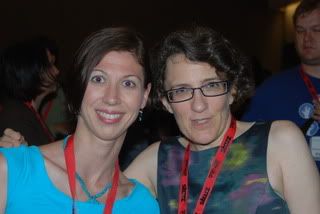
ScriptPhD.com was extraordinarily grateful to the SyFy Channel and Jane Espenson for granting us the opportunity to ask a few preview questions. We wanted to ensure ScriptPhD fans’ questions got answered and that we could bring you exclusive scoop that you can’t find on any other site. Here is what Jane had to say about the show, her career, and a look back at BSG:
ScriptPhD.com: A lot of fans know you from your brilliant work on Buffy the Vampire Slayer, The Gilmore Girls, and most recently Battlestar Galactica. But what a lot of fans don’t know is that you had a most atypical entry point into the Hollywood scene. You studied linguistics at UC Berkeley, both as an undergraduate and a graduate student, with some very impressive academic achievements before getting noticed for your Star Trek: The Next Generation spec script. How do you feel that the rigors of academic study prepared you for Hollywood, writing for TV, and now, being a showrunner?
Jane Espenson: Wow, interesting question — I have no idea if it’s going to lead to an interesting answer, but let’s give it a try! My graduate work was in a very specific part of Linguistics/Cognitive Science — I studied metaphor, not as a literary device, but as an important part of how we conceptualize the world around us. In a way I suppose it’s a very science fictiony area of study because it’s all about the ways our brains translate our abstract interactions with the world into OTHER kinds of interactions with the world. There’s something very “V-world” going on even inside our own brains, to use some of the parlance of Caprica. The climate of inquiry and open-mindedness that I encountered in school is very much like what you find in the writers’ room of a science fiction television show. And, of course, science fiction is inherently about metaphor — understanding our world by filtering it through a different set of rules. There are days in which what I did in school feels very separate from what I do now, and days in which it feels like I never left — like it’s all part of the same inquiry. But now I get to write for robots!
SPhD: This is a Battlestar Galactica: The Plan question from our fan Grey. He brought up the interesting point that the Cylon John Cavil has one of the most fascinating, perplexing roles in this movie (and arguably the Galactica story). His character seems to contradict himself philosophically and morally a lot. Just as the Cavil on Caprica learns to trust from Anders and the Resistance, the Cavil on Galactica seems to learn not to trust from Ellen and the other Cylons. Indeed, the Caprica Cavil has a point blank shot at Starbuck and he doesn’t kill her, but viciously knifes the little boy that befriended him on the Galactica ship. Do you have any thoughts on this?
JE: Yes, exactly — the two Cavils go on different journeys that lead them to diverge. The Cavil on Caprica learns a lesson that the Cavil in the fleet doesn’t learn. Caprica-Cavil learns that the love for humanity is going to survive even if humans themselves don’t. He doesn’t take the shot at Kara and he comes to view the entire attempted genocide as a massive error. Fleet-Cavil has other experiences in which the Cylons who surround him are repeatedly rendered useless by the affect humans have on them. When even he starts to feel the appeal of humanity, he lashes out at the orphan boy. He steels himself against humanity and his views become more and more unforgiving. By the end of The Plan, the two Cavils have very different opinions on the actions they’ve already taken, and what they should do next. Events of the end of the BSG series tell use which position was adopted by the other Cavils. (It wasn’t the more loving one.)
A Caprica question from another fan, Iqbal. He wonders if the show Caprica will explore moral ambiguity not just in surface concepts, but really try hard to pull topics from our own contemporary struggles (two wars, religious conflict, health care, the failure to engender proper economic reform, etc) in ways that defy the superficiality of the mainstream media as well as explore historic issues — as some of your best collective work on BSG did?
JE: We made a real attempt to make sure we were writing episodes, not essays. But, yes, absolutely, matters of religious conflict, abuse of government power and cultural bias are so thoroughly cooked into our show that the episodes inevitably explore these issues. And moral ambiguity is really the key to the show. The characters on our show tend to believe that their personal values are the key to keeping their world from sliding to its destruction, so they’re all driven by highly moral principals from their point of view, which may not be at all the view of the other characters or of the viewers. This was really exciting stuff to write. So yes, we do address contemporary issues, but we don’t bend the show around to focus its lens on the issues — we let it occur naturally as the stories take us there.
SPhD: A really fun Caprica question from our fan Josh! In the Caprica pilot, we saw the END of a professional pyramid C-Bucs game where they left the court….is it possible the writers might incorporate an actual Pyramid game for us to see on Caprica?
JE: Yes! We will see parts of games. It turns out that large arenas, and more importantly, large crowds are very expensive to film, but you will definitely see and hear some game play. Both the team and Atlas Arena itself will be very important to our story as it unfolds.
Film director and screenwriter Bryy Miller is the president of Lefty Films.
~*Yorick Archer*~
******************
ScriptPhD.com covers science and technology in entertainment, media and advertising. Hire our consulting company for creative content development.
Subscribe to free email notifications of new posts on our home page.
]]>
Our Fall Science Television preview concludes with our last installment. ScriptPhD.com give you a sneak peek of the conclusion of Warehouse 13, the hit reality show Destination Truth, and new series V and the delectable, highly-recommended ScriptPhD.com pick for best new fall show, Stargate Universe. I sincerely hope that our three-part guide to some (though not all) of the vast and rising science and technology content on television was a helpful guide and provided you a variety of options from shows returning and launching as you embark on your Fall TV seasons. Wishing you all full TiVos and busy remotes!

V
Season premiere on November 3rd on ABC.
Where were you when JFK was assassinated? Where were you on 9/11? Where were you this morning? These ominous questions, flashed for the audience at the beginning of the V pilot, are intended to convey: something important is going to happen. Using an excruciatingly suspenseful build-up to introduce the main characters, a series of shaking events leads to a spaceship hovering over New York City and, as it happens 29 others around the world. [Those of you who enjoyed District 9 are not hallucinating at the V poster–you will note some quite obvious parallels in this show.] There is some spectacular imagery and special effects in play as a blinding light reveals a surprisingly beautiful human face–Anna (Morena Baccarin), the leader of a stranded people, in search of sustenance and replenishment, all in exchange for their advanced medicine and technology. Everything seems peaceful, idyllic and perfect. Seems.
Right away, amidst an outpouring of affection and goodwill, incongruities pop up. The “V”‘s (visitors) are curing diseases, giving rides in spaceships, and boosting local economies. But the ambassador Anna will only give a filtered, staged interview about her people to an ambitious TV reporter (a delightfully smarmy Scott Wolf). The V Ambassador Program to spread their culture and beliefs seems more akin to a cult–one that snares the son (Logan Huffman) of FBI Agent Erica Evans (Lost alum Elizabeth Mitchell). All this devotion to the V’s arouses the suspicion of Father Jack Landry (Joel Gretsch) despite people flocking to churches. He is warned that the V’s are really out to obliterate humanity and are not what they seem. An unrelated piece of evidence–that terrorist chatter is up since the arrival of the V’s–yields a secret New York City terrorist cell with C4 explosives.
The two plots fuse together in an ending that is so shocking and central to the extended plot of the show, that ABC asked critics not to reveal any of it. And really, why would we want to ruin your fun? Suffice it to say that the “reveal” of the global spaceships was Part I of an elaborate deleterious plan already set in motion decades ago. Global figures, senators, politicians, everyday people are not who you think they are. The infiltrators will surprise you. And some of their actions will surprise you even more. V, armed with an excellent ensemble cast and terrific writing, explores some salient, important themes; the destructive power of unchecked devotion, and the need of human beings to believe in something in the face of daunting adversity, but at what cost? The consequences are dire, the foes fiercely armed, and the ultimate war will be launched. Let’s hope that what was a thoroughly satisfying, intriguing pilot is developed into a cogent, well thought-out piece of science fiction.
While not as tightly composed as the wonderful FlashForward, V still has some fine acting, suspense, some genuine surprises, and a mysterious story arc that should keep me watching at least through the first season. A definite ScriptPhD.com sci-fi pick.

WAREHOUSE 13
Season finale airs on September 22, 2009 at 9 PM on SyFy.
One of this summer’s unexpected (and inexplicable) hits, breaking out as one of cable’s top 10 programs, was SyFy’s original procedural about a team of United States secret service agents working in the government’s secret Warehouse 13, a storage unit in the middle of South Dakota, that houses supernatural objects, relics and artifacts from history. Fallen agent James MacPherson (how much do we love Roger Rees? So much!), an archnemesis of the team throughout the first season, reappears in the season finale, properly entitled “MacPherson”, brings this conflict to its climax and conclusion (or is it?)
The ScriptPhD has screened the season finale, and can verify certain questions are answered while others are raised. MacPherson, having absconded with the fire-resistant phoenix medallion, along with other artifacts, plans to sell them for nefarious purposes. In the hunt to retrieve them (and him), it is revealed that computer whiz Claudia Donovan knows James, and may have even had help from him to hack into the Warehouse computer system. Just as Agents Lattimer and Bering bring him in to be permanently bronzed (seriously, I said bronzed), something unexpected happens, and MacPherson receives help from the person you least suspect. Someone will have possibly perished, someone is a traitor in the midst (and it’s the person you least suspect), and a whole new season’s worth of mystery is set up in the last five minutes.

DESTINATION TRUTH
Airs Wednesday nights at 9 PM on SyFy
For those of you looking to spice up your science reality beyond the occasional National Geographic special, you might consider SyFy’s popular reality hit Destination Truth. Like its network sibling Ghost Hunters, the show, now in its third season, focuses on diffusing the occult and unexplained through the scope of research and the scientific method. Think Survivor meets MacGyver. With a training in both dramatic arts and archaeology, host Josh Gates uses acting chops and bona fide science credentials to look into the world’s most intriguing unexplained mysteries… with flair. At times cheesy [seriously, throw anyone into a pitch-black environment with a night-vision camera and it will engender spookiness] and other times truly interesting [an exploration into the unexplained paranormal hauntings of the Romanian Hoia Baciu Forest ends up with some unexpected results], Truth Hunters still manages to entertain while informing. Josh and his team still examine the evidence using all the technological tools in their arsenal–soil and water samples, thermal imaging, electromagnetic imaging, etc–to come to a science-based conclusion, and only makes definitive statements if the trail of evidence allows it. That, and did we mention the scenery is gorgeous!
This season promises many exciting adventures, with Josh traveling the far corners of the world, including the Himalayan kingdom Bhutan, the heart of Chernobyl, home of the worst nuclear accident in history, an overnight stay in King Tut’s tomb and dives in ancient Caribbean caves.
And finally, I’ve saved the best for last…
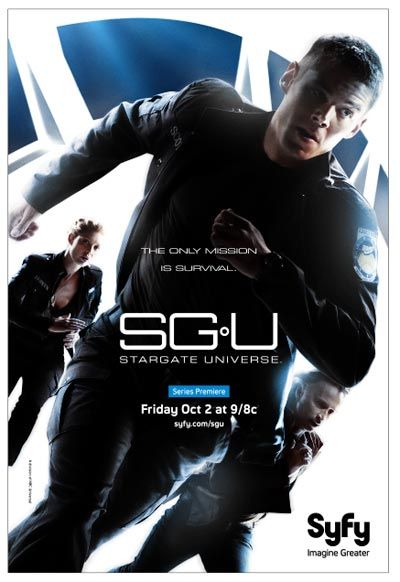
STARGATE UNIVERSE
Series premiere airs on October 2nd at 9 PM on SyFy.
Imitation, while always the sincerest form of flattery, can sometimes be a double-edged sword. And in the world of television, especially when emulating a Peabody award-winning series such as Battlestar Galactica, it’s a huge risk. From the first shots of austere, dilapidated oblong tube-like hallways of a base ship, it’s obvious that new series Stargate Universe is channeling the spirit of its just-concluded post-apocalyptic cousin. Like in Battlestar, a group of humans fight for their survival on a displaced vessel far from home under savage conditions. There are FTLs, coordinates, and ship jumping galore. There is also a deeper subtext woven into the microcosm that explores the deeper existential issues of justice, science and reason versus emotion and might, and cohesiveness across race and class. And like Battlestar, it makes for compelling, incredible television.
Eli Wallace (David Blue), an MIT dropout video game nerd, is approached by the Secret Service and informed that the secret weapons puzzle he mastered required solving an ages-old math proof. “What are you going to do, beam me up to your spaceship?” he deadpans when they attempt to enlist his help in a project. Yes, actually. Eli finds himself aboard a hyper-secret US government military mission-a hidden baseship deep in outer space. He must solve an ancient language to navigate a Stargate, a millenia-old portal allowing instant transportation anywhere in space that has been modified due wormhole dangers. Only when the base comes under attack unexpectedly, the crew aboard must jump through the Stargate unknowingly for their survival. which is where the Stargate Universe story begins. A group of soldiers, scientists, and civilians end up on an ancient ship–appropriately named the “Destiny–headed on a self-driven course millions of light years away from Earth and completely unsuited to support them.
What had started out as a high-tech mission to outer space becomes an instinctual fight to survive, subsist and get along. Serving as a primer of the weekly exploration, science and humanistic backstories that will serve as the platform of the larger story arc, one of the first episodes centers around a mission to a nearby desert planet to find chemical lye to neutralize carbon dioxide threatening the crew of the ship. A book-smart but socially stunted Dr. Nicholas Rush (Robert Carlyle) butts heads with a formerly incarcerated headstrong Master Sgt. Ronald Greer (Jamil Walker Smith) over the best course of action, while a power struggle plays out between Colonels Telford (Lou Diamond Phillips) and Young (Louis Ferreira) over who is in charge of the new ship. Backstories of the characters’ lives back on Earth, told in timely flashbacks, provide a tapestry of ghosts and demons that each is carrying with them aboard the Destiny. With action, sleek sets and high-quality CGI that combine with flawed yet likeable characters forming personal connections under impossible conditions, Stargate Universe is not only instantly-addictive, it’s easily the best new show of the fall season.
To answer a burning question many fans may have, you do not need to have familiarity with erstwhile Stargates (SG-1, Atlantis, etc) to fully enjoy the experience of Stargate Universe. All questions about how the Stargate portal works, and its role in the universe depicted in this spin-off, are addressed in the pilot. The ScriptPhD screened the first three episodes with no knowledge of the aforementioned and was able to thoroughly enjoy the series.
~*ScriptPhD*~
*****************
Follow ScriptPhD.com on Twitter and our Facebook page. Subscribe to email alerts for new posts on our home page.

